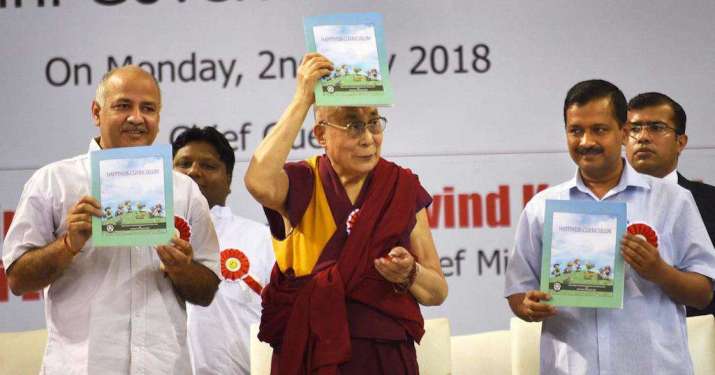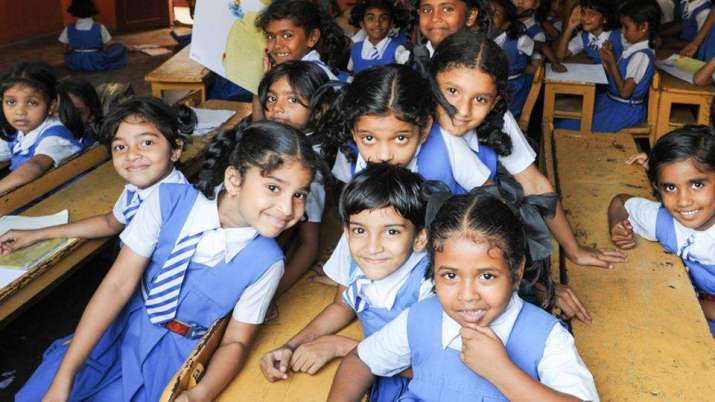FEATURES|THEMES|Social Engagement
Dalai Lama Launches “Happiness Curriculum” for Schoolchildren in New Delhi
 Deputy chief minister Manish Sisodia (left), the Dalai Lama (second from left), and chief minister Arvind Kejriwal at the launch of the happiness curriculum in New Delhi on Monday. From
Deputy chief minister Manish Sisodia (left), the Dalai Lama (second from left), and chief minister Arvind Kejriwal at the launch of the happiness curriculum in New Delhi on Monday. FromA new curriculum devised by the New Delhi government’s education department was launched by His Holiness the Dalai Lama on 2 July. Dubbed the “Happiness Curriculum,” it focuses on the concept of holistic education based on personal wellbeing through meditation, moral teachings, and mental exercises. The core idea is to produce sarvagun sampann (versatile) professionals and human beings who can serve society as happy individuals, and enhance the experiences and personalities of future generations, influencing positive national development. The curriculum is intended for 800,000 schoolchildren from nursery to class VIII at some 1,000 schools in New Delhi.
Deputy chief minister of New Delhi, Manish Sisodia, who holds ministerial portfolios in education and higher education, said: “[The] purpose of education for students is not merely to get high marks. [The] education system needs to produce happier, confident, and self-aware citizens. It is these self-aware citizens who will create a better society.” He expanded on the purpose of education as fulfilling a “larger moral and societal purpose.” Stating that education cannot be developed in isolation from the needs of society, “even as we aim for economic equality, we must also strive for happiness equality,” he said. (Business Standard)
The city’s education department has decided to offer the Happiness Curriculum as an alternative path to conventional teaching methodologies amid the backdrop of horrific cases of violence reported in schools, including the murder of a student at a private school in Gurugram and the rape of a four-year-old by her classmate in the Indian capital. “All these instances make us realise that it is not enough to improve students’ exam performance. There is a need for a more fundamental re-look at the purpose of education. Many of the perversions we see in society are due to our education system not being able to answer questions of human happiness and fulfilment,” said Sisodia. (Millennium Post)
Before developing the curriculum, Sisodia visited Harvard University, which is also running a happiness course for students. After he returned to India in January, the New Delhi government, in collaboration with the State Council of Educational Research and Training, commissioned a team of 35–40 experts, including public school teachers, to prepare a framework for the curriculum.
The curriculum has no textbooks. Instead, it is activity-based and no formal examinations are conducted—only periodic assessments of the children’s progress will be made using a Happiness Index. The activities of the curriculum are for teachers and students to perform every day. In one activity, teachers create a context in which they can talk with students about their feelings on pressure concerning studies and exams or family expectations.
Sisodia has appealed to teachers and students to come forward and assist in developing the Happiness Curriculum. He said the government has moved to transform the infrastructure and capacities for public schools to enhance learning outcomes through new interventions. “After 10 years or more, these children will become professionals like doctors and engineers filled with happiness and serve the society,” said Sisodia. “They will be less likely to get involved in violence and corruption.” (Business Standard, The Hindu)
 From hindustantimes.com
From hindustantimes.comAlthough it is one of the largest economies in the world, India is not always a happy place to live. The World Happiness Index 2018 ranks India at 133 out of 155 countries, a significant drop from its 122nd placing last year. Across diverse cultures, happiness and the path to it remains a burning issue. This is an especially important issue for children as they suffer from performance stress, constant pressures to perform better than peers, fear of failure, and societal and parental emphases on good academic performance. The meditation techniques adopted in the Happiness Curriculum could help children develop a more positive outlook and reduce stress, hopefully leading to students developing a positive outlook toward life and being able to concentrate more easily in class.
As the curriculum is based on moral teachings and meditation, it will allow students to practice meditation aimed at dealing with emotional issues such as anxiety, anger, hatred, lack of concentration, doubt, laziness, greed, and restlessness. This practical training for schoolchildren and their teachers can result in better concentration, enhanced memory, self-confidence, and higher productivity and efficiency. Further goals include cultivating compassion and joy in relation both to themselves and other sentient beings. Following an improvement in relationships with schoolmates, teachers, and parents, the happiness curriculum’s shapers hope that children will more easily stay away from adolescent delinquency, including drug addiction and teen pregnancies.
In 2014, a similar curriculum was introduced by the state government of Maharashtra. It offered anapana meditation for a short period of time to 25 million primary and secondary schoolchildren in school. They initiated a project called “Mitra Upakram” to introduce anapana meditation practice. The objective was to increase interaction among students and facilitate communication and friendships among students.
Anapana meditation teaches practitioners how the natural breath is connected with our state of mind by focusing on the incoming and outgoing breath at the entrance of their nostrils without trying to change the flow. The Global Vipassana Pagoda in Mumbai played an important role in this project and encouraged all schools in India and worldwide to adopt the meditation course as part of their daily school curricula.
It is hoped that through the new Happiness Curriculum in New Delhi, students will learn to break the cycle of anxiety, anger, and frustration when they face difficulties in their school lives. In this initiative, parents can also become involved with their children during exams and other school matters.
See more
Delhi government readies Happiness Curriculum for students (The Hindu)
Delhi govt. schools to have ‘happiness curriculum’ from nursery to Class VIII (The Hindu)
Happiness curriculum in Delhi government schools from July: Deputy CM (Hindustan Times)
Happiness curriculum in Delhi govt schools from July: Deputy CM (Business Standard)
Delhi govt to launch 'happiness curriculum' from July in its schools (Millennium Post)
Mitra Upakram - Anapana Meditation for 25 million School Children (Global Vipassana Pagoda)
India ranks 133 in global list of happiest nation, Pak fares better: UN report (Deccan Chronicle)
Related features from Buddhistdoor Global
Mindfully Ending Addiction
Educating Buddhist Children in America
Happiness Before Profit: Bhutan Seeks to Redefine Business Using Buddhist Values
Happiness, Expectations, and Learning to be Losers: An Interview with Ajahn Brahm
Related news from Buddhistdoor Global
US Schools that Have Replaced Detention with Meditation Are Reaping the Benefits
Mindfulness Key to Unplugging Children from Online World, Says British MP
Buddhist Monk Matthieu Ricard: Veganism is the Key to Lasting Happiness














